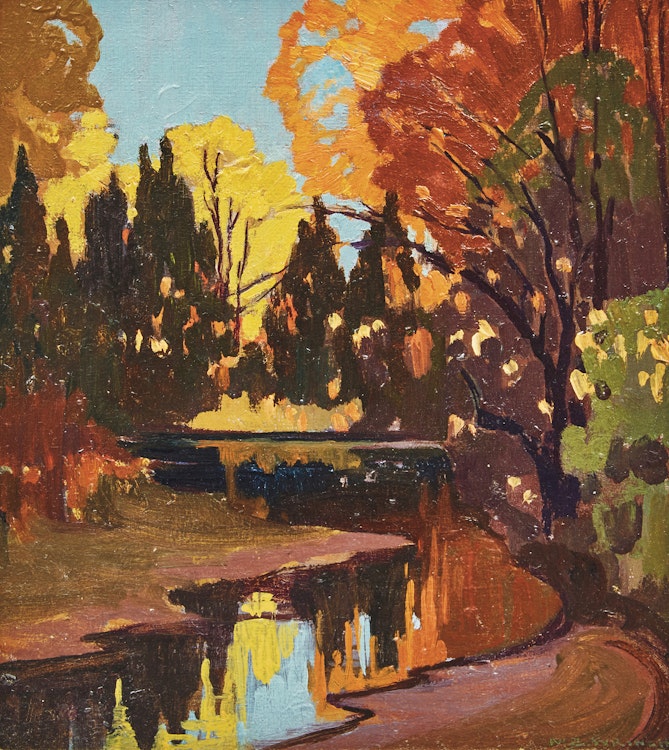Falling Leaves by Mary Evelyn Wrinch

Mary E. Wrinch
Falling Leaves
oil on canvas on board
signed lower right; signed and titled on a label on the reverse
10 x 9 ins ( 25.4 x 22.9 cms )
Auction Estimate: $4,000.00 - $6,000.00
Price Realized $4,560.00
Sale date: June 8th 2023
Collection of the Artist
Gordon Conn, Toronto, 1965
Private Collection, Ontario
“Canadian Small Pictures”, Canadian National Exhibition, Toronto, 1931, no. 732
Joan Murray, “Mary Wrinch”, Canadian Antiques Collector, Volume 4, September 1969, page 17
Mary Wrinch`s “Falling Leaves” is an exercise in pattern. The trees are echoed in the water; the water reflects their colour and the sky. The banks of the stream are set off by black paint to either side. Amid a network of repeated forms, the structure of the painting is firmly anchored by the dark colours Wrinch used to outline and enhance specific areas. Works from the 1920s and 1930s are her landmarks and in them she energetically explored artistic process, colour and semi-abstraction in and around two dimensions. The bold design of “Falling Leaves” suggests Wrinch`s long-held knowledge of Paul Gauguin and the Nabis, the group of artists particularly influenced by Gauguin's expressive use of colour and rhythmic pattern. Wrinch knew of Gauguin from her friend, painter Harriet Ford, and also may have thought here of Gauguin's style with its vigour and decorative simplicity and sought to use her understanding of his work to heighten the effect of this quiet, intimate space and the sparkling beauty of the Canadian landscape.
The artist valued this work and liked the composition and colour so much that she made a colour block print of it titled, appropriately, “Falling Leaves”. She also painted a larger canvas with the title “Falling Leaves”, an oil on board, 16 x 13 inches (sold at Sotheby's Canada, May 15, 1973, lot 238). She kept the sketch until shortly before her death.
Share this item with your friends
Mary Evelyn Wrinch
(1878 - 1969) OSA, ARCA
A painter and printmaker, Mary Wrinch immigrated to Toronto from England in 1885. The artist made this city her home base, from which she ventured into the Ontario northland to paint, particularly around Lake Muskoka. Remarkably, Wrinch adapted her modernist style to this landscape years before the Group of Seven became famous for depicting the same region. Her art education began at the Central Ontario School of Art in Toronto (now OCAD), where Wrinch studied under Robert Holmes, Laura Muntz, and G. A. Reid (whom she later married, in 1922), graduating in 1893. She subsequently travelled to London, England, to further her training at the Grosvenor Life School under Walter Donne until 1899, and to study miniature painting under Alyn Williams. Her education continued at the Art Students' League in New York, where she also received private lessons in miniature painting from Alice Beckington. She was elected an associate of the Royal Canadian Academy in 1918, and was also a member of the American Society of Miniature Painters (1902), the Ontario Society of Artists, the Society of Canadian Painter-Etchers and Engravers, the Canadian Society of Graphic Art, the Women's Art Association of Canada, and the Canadian Handicrafts Guild. In addition to exhibiting with these associations, she participated in the Canadian Painting Exhibition at the Art Gallery of Toronto (where her work was displayed alongside that of several members of the Group of Seven), the British Empire Exposition in Wembley, England (1924), and in a show at the Tate Gallery, London (1938), among many other exhibitions. She is represented in the collections of the Art Gallery of Ontario, and the National Gallery of Canada.

